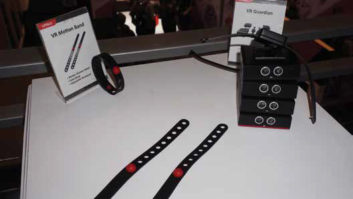TVs with OLED, Crystal LED, 3D, and 4K were the Buzz of the Show

China-based TCL, was among those showing “dual view” sets. Here you see both images, but with glasses having either two “Left polarized” or two “right polarized” filters you get a clear view of just one image.
For many custom installation firms, video displays are a “can’t live with them/can’t live without them” proposition. On one hand, they are the bane of your existence thanks to severe price compression for flat screens. On the other hand, large displays and front projection systems still represent a major ingredient to most successful installations. To help you make the best of the hot display scene at last month’s CES, I’m devoting all of my show report this year to some of the important details behind all the noise over displays at this year’s CES.
OLED is for Real This Time
Long a science experiment, and only commercially available in North America, previously, as part of small screens in control touchpanels, phones, and tablets (or in the now-discontinued $2,500, 11- inch Sony set) large-screen OLED displays were featured prominently this year in the Samsung and LG CES booths. While neither company would quote prices or exact delivery dates, both promised to have 55-inch OLED sets available this year.
The image quality on the OLED demo sets in both booths was unlike anything you have seen in an LCD set. Indeed, some observers thought the pictures were, if you will, “too good” and a bit over saturated. Suffice to say, these display images were that kind you could really fall in love with–no more gray “masquerading” as black.


LG’s OLED set is claimed to be the thinnest available, as demonstrated against a side view of an iPhone. You can see the phone, but the display is hardly visible!
Along with the stunning pictures there was, of course, full 3D–passive for LG and active for Samsung. That is one of the things that differ between the two brands’ sets; and despite a common screen size (55 inches wide), the same resolution (1080p), and similarly thin bezel designs, there was one other key difference that is literally behind the screen. While both use emissive OLED technology for the higher contrast and lower power consumption thanks to the individual pixels being “on” only when needed, the Samsung unit is composed of individual red, blue, and green pixels. The LG unit takes a different approach, using white illumination that also turns on and off at the pixel level, but the light shines through sub-pixel color filters. With the sets in different booths, it was impossible to do a side-by-side comparison, making it difficult to say if one approach delivers better pictures than the other. The technical difference could, however, mean that the LG set might be a bit less expensive than the Samsung.
With all the attention generated by the OLED sets from the Korean giants you would be correct to wonder if there was any reaction from their Japanese competitors. Sony, Panasonic, Toshiba, and Sharp instead chose to commit to other advances in displays for now.
Sony’s Crystal LED
Sony chose CES for the first public showing of a technology that might compete with OLED. Named “Crystal LED,” it uses an array of more than 6 million LEDs and individual red, blue, and green LEDs for each pixel. The easiest way to describe how these sets work is to think of the individual light bulbs or LEDs in a stadium and then to picture that array-style display shrunken down into the true “full LED” backlighting array.
Like OLED, the Crystal LED technology is an emissive display, creating high-contrast images with a wide color gamut. Also like the OLED sets, Crystal LED had incredibly clear 1080p images, and the set’s size was also 55 inches diagonal. Unlike OLEDs, however, the Crystal LED sets were clearly described as being a technology demonstration with no indication if, or even when, they might be put into mass production. Pricing was also not discussed.

Displays featuring the 21:9 aspect ratio were at CES from Vizio, ChangHong, and a few others.
Other Items of Interest
Despite its lack of popularity, 3D has become an expected feature on most large-screen sets above 47 inches and above budget pricing. For clients or prospects that object to 3D, the easiest path is to simply remind them that a good 3D set is generally a great 2D set. Tell them to ignore the 3D feature and forget about the glasses, and they’ve still got a great high-end set with the latest and greatest.
Keep in mind, however, that the quality of 3D sets is improving, and those on display at CES did have better images than last year. As to the “battle of active versus passive,” there has been little change other than to say that active glasses are getting lighter and somewhat less expensive, and passive glasses are now available from a wide range of third-party suppliers in a wide range of sizes, colors, and fashion looks. For those who wear prescription glasses, the “EX3D” flip-ups” for passive displays from Marchon were one such advancement that might be useful in easing the transition to 3D.
For those objecting to the whole idea of 3D glasses, the prospect of practical auto-stereoscopic displays might be the answer. There were more demonstrations of these “glasses-less” sets this year, but the difference was that Toshiba actually committed to selling a set in the North American market during 2012. The manufacturer has not yet announced the precise screen size, price, or exact introduction date, but it put its cards on the table with a commitment.
4K Momentum Builds


Toshiba’s TRAC is an example of using tablets as a complete remote for a display without having to put any menus up on the screen.
The trend toward “4K” displays continued at CES, with a Toshiba unit that will have a 3,840 x 2,160-resolution screen capable of delivering nine 720p images in 3D. In conjunction with face tracing and a sophisticated, yet easy-to-use, interface, this overcomes some of the objections to earlier auto-stereo sets about the viewing angle. Clearly, there is a trade off between resolution and the number of discrete viewing positions, but most viewers will definitely take the latter over the former. As an additional advantage, when 2D material is being viewed, it is upscaled to pure 4K.
Panasonic also talked about a small-size 4K monitor while LG took the large end of the 4K spectrum, with an 84-inch, ultra-thin LCD set that will be available this year. Samsung’s 4K set was shown as a technology demonstration, but no introduction date was announced.
For those who say that the absence of 4K content renders the resolution useless, JVC introduced a 4K camcorder. And all of the 4K sets will upscale incoming video to the native 4K resolution, but for those looking for an alternative 4K source, Sony will soon be selling a Blu-ray player with 4K upscaling.
For stretching the aspect ratio of a display without going to the flexibility of a front projector (where there were, by the way, 4K units as well), Vizio showed a 21:9 LCD set in a 58-inch diagonal size, and 21:9 displays were also shown by China-based Changhong.
Dual-View Options
Another “stretch” is not to the screen’s aspect ratio but rather to the number of programs or game views available on a screen. Sony first previewed its 24- inch dual-view set at the E3 gaming show, and it is capable of either 3D images or two separate game-view images, depending on how the active glasses are switched. As a proponent of passive 3D, LG will offer “Dual Play” on some of its upper-line sets this year. The glasses will not be as expensive as the Sony active glasses, but they will not be the same as the glasses used for 3D. The dual-view glasses have either two “left eye” filters or two “right eye” filters, each circularly polarized in the opposite direction.
Connectivity and Control

Samsung’s OLED offering
With the video display “size wars” of past CES years having quieted down a bit, “connectivity” has become the word of the moment from virtually every display brand. It is not just a matter of offering services, as after a while they all boil down to different takes on the same collection of movie services and applications. The differences come more in the way the connected services are accessed and managed as well as the “apps” and services themselves. Some brands, including Sony, LG, and Vizio, took advantage of the latest incarnation of Google TV. The search interface is greatly improved from the original version, and we’ll get back to that in a longer comparison piece on connected services products in a future issue.
The list of brands and models with connectivity and apps is longer than space permits here. With that it behooves anyone involved with large-screen displays to look into the specific services each of the brands on your line card offers.

Sony’s Crystal LED had great images thanks to discrete RGB LEDs for every pixel in the 1080p screen, but it is still a prototype with no price or introduction date announced.
A variety of methods of set control and content management will be available as the 2012 model line sets are introduced. Toshiba offers the ability to transfer setup and control to a tablet. Voice command is also back as a way to control displays, with LG among those offering voice and Kinect-like gesture control. Samsung went one step further with facial recognition along with voice and gesture control, so a built-in camera senses who the viewer is and presents their preferred apps and settings without the need for menu navigation.
A bit out in the distance were models shown by computer giant Lenovo that provide the combination of voice, gesture, and facial recognition in addition to a “fully baked in” version of the Android 4.0 “Ice Cream Sandwich.” The camera there can be used as a web cam, competing with the “Skype on-board” equipped sets that post-CES also now include Panasonic Viera models.
These notes are only the tip of the display iceberg for products from this year’s record-breaking CES. Along with the focus on OLED and new technologies, there were also new plasma sets from Panasonic, LG, and Samsung. There were a wide range of soundbars and audio systems to go with the displays, and we haven’t even begun to delve into the world of networking, set top boxes, and accessories. Don’t worry, the year is young, and we’ll focus on all of this as the months move forward.
Michael Heiss ([email protected]) is a contributing editor to Residential Systems in Los Angeles, CA.




